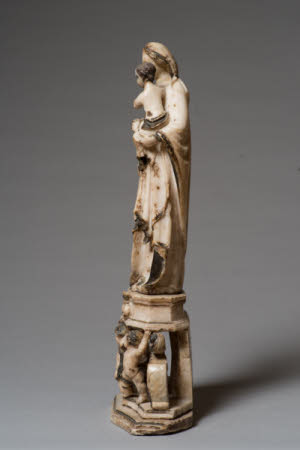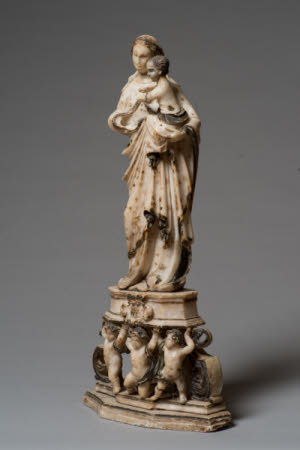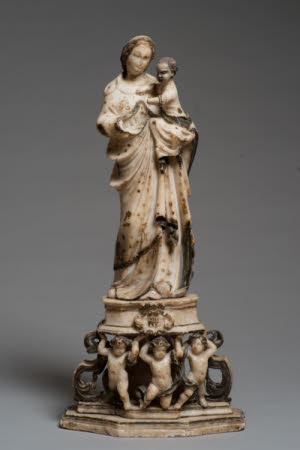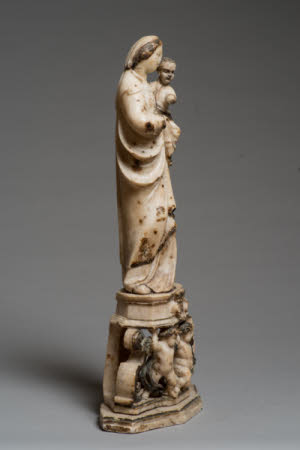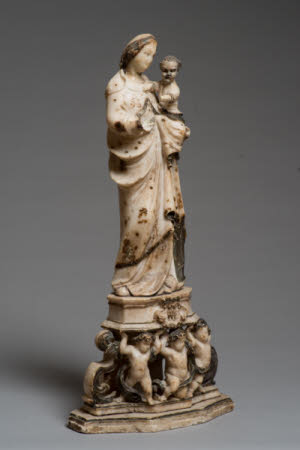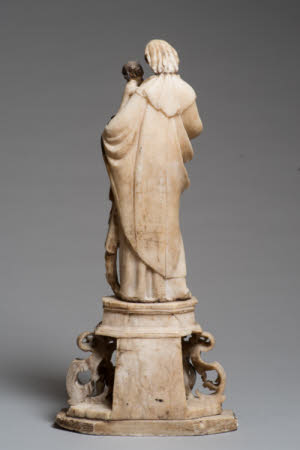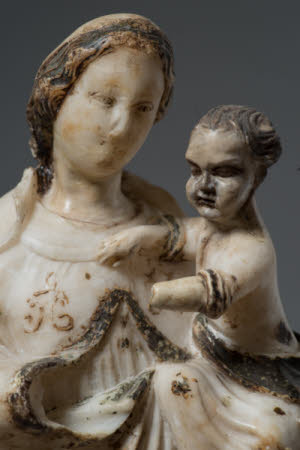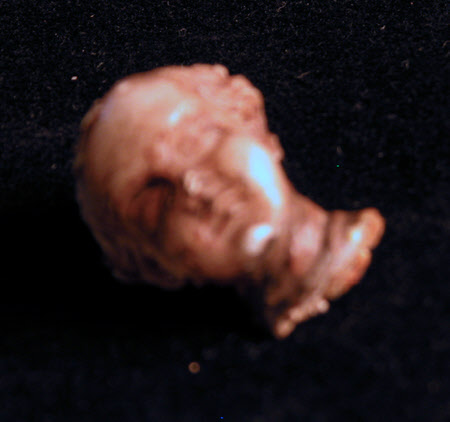The Madonna of Trapani
Sicilian (Trapanese) School
Category
Art / Sculpture
Date
1650 - 1700
Materials
Alabaster
Measurements
30 x 195 x 90 mm
Place of origin
Trapani
Order this imageCollection
Anglesey Abbey, Cambridgeshire
NT 516604
Summary
Alabaster, The Madonna of Trapani, Sicilian (Trapanese) School, c. 1650-1700. A partly painted statue in alabaster depicting the Madonna of Trapani, made in Trapani c. 1650-1700. The Virgin, heavily draped, holds the Christ Child on her left arm. Christ originally had both hands on the chest of his mother, who with her right hand touched the hand of her son. Left section of drapery carved so that it is detached from main body of figure. The figure is mounted on an octagonal pedestal with, at the front, two large volutes and three naked putti, all set upon another octagonal base. At the back is a support in the form of a solid stone section. The base beneath the Virgin bears the arms of the city of Trapani.The sculpture is flattened at the back. The Virgin’s right hand and the Christ Child’s left hand are broken off and the right hand fingers are also missing. Christ’s head has been detached and reattached, with old restoration covering the face and the neck area. The plinth has been broken in two, with the right-hand facing scroll heavily restored as well as the leg of the right-hand infant.
Full description
The Virgin of Trapani is a miraculous life-size sculpture of the Virgin and Child kept in the Basilica and Sanctuary of Maria Santissima Annunziata in Trapani (for the Virgin, her cult and copies, see Cassata 2003, pp. 109-23). The statue is usually attributed to the Pisan sculptor Nino Pisano (active c. 1343-died before 1368), but seems more likely to be the work of an unknown Pisan master (Moskowitz 1986, pp. 156-57, figs. 313-15, attributed to an anonymous Master of the Sta Caterina Annunciation). It quickly became the object of devotion, making Sicily and the city of Trapani in particular one of the major pilgrimage destinations in Europe. The production of copies began early, the best reproductions being the early ones, some of which were made by major sculptors such as Francesco Laurana and Domenico Gagini (Kruft 1970, pp. 297-322, figs. 5-13). Whereas in the fifteenth and early sixteenth centuries, copies of the Virgin of Trapani were often made at full size, from the late 16th century onwards vast numbers of small reproductions began to be made in workshops in the city, in a variety of materials, alabaster, coral, ivory. The popularity of these images, intended often for domestic devotion rather than for display in churches, reflects the fame at this time of the Sanctuary in Trapani, which attracted pilgrims from throughout the Mediterranean. In 1698 Vincenzo Nobile wrote that ‘there is no foreigner who arrives in Trapani who has not taken back with him to his own country some statuette of Our Lady in coral or in alabaster to provide for his devotions and those of his fellow countrymen’ (‘non viene in Trapani forestiero che non riporti seco alla Patria qualche statuette di corallo o di alabastro di Nostra Signora per provvedere alla devotione sua e dei paesani.’ Vincenzo Nobile, Il Tesoro nascoso. Discoperto a’tempi nostri dalla consacrata penna di D. Vincenzo Nobile trapanese, Palermo 1698, p. 579). The Jesuit Wilhelm Gumppenberg recorded in 1672 that there were around forty workshops in Trapani, in which the principal occupation was the production every year of around 5,000 small images of the Madonna of Trapani, mostly in alabaster, but also in coral, the material for which Trapani is best known. Most of these were exported from Sicily by the many pilgrims, but nevertheless Gumppenberg recorded that there was hardly a house to be found in Sicily that did not contain a reproduction of the Madonna of Trapani (Guilielmus Gumppenberg, Atlas Marianus, Munich 1672, p. 120). In later centuries many sculptors from Trapani emigrated to other European centres, including Gibraltar and London, where they continued to make copies of the Madonna. The Anglesey Abbey statuette must have been made in the same workshop as a larger example in the Palazzo Vescovile in Trapani, with an almost identical supplementary base formed by three naked putti who support the volutes and the coat-of-arms (Cassata 2003, p. 116, no. I.4). These putti have been compared to the carved putti on the case of the organ, made c. 1696, in the church of Santa Maria del Soccorso (or the Badia Nuova) in Trapani (Scuderi 1994, p. 41, Tav. LV, Fig. 69). A medium-sized copy in the Skulpturensammlung of the Staatliche Museen, Berlin has oxen supporting the base on which the Virgin stands (Kruft 1970, fig. 15). Given the output of the Trapani workshops, it is not surprising that numerous examples of statues of the Madonna of Trapani survive to this day in private and public collections. There are examples in ivory in the British Museum (Inv. 1856,0623.155; O.M. Dalton, Catalogue of the Ivory Carvings of the Christian Era […] in the British Museum, London 1909, p. 167, no. 537, Pl. CXXII) and in the Victoria and Albert Museum (Inv. 984-1907; Marjorie Trusted, Victoria and Albert Museum. Baroque and Later Ivories, London 2013, pp. 301-02, no. 295), and three in alabaster in the collection of the Hispanic Society in New York (Figures of the Madonna of Trapani in the Collection of the Hispanic Society of America, New York 1927). Jeremy Warren 2020
Provenance
Acquired by Huttleston Rogers Broughton, 1st Lord Fairhaven (1896-1966) before 1932; listed in the Anglesey Abbey inventory, 1932, p. 69, The Prior’s Room, valued at £10; Anglesey Abbey inventory, 1940, p. 694 The Prior’s Room, valued at £10; bequeathed to the National Trust by Lord Fairhaven in 1966 with the house and the rest of the contents.
Credit line
Anglesey Abbey, The Fairhaven Collection (The National Trust)
Makers and roles
Sicilian (Trapanese) School, sculptor
References
Cassata 2003: Giovanna Cassata, ‘Le copie “piccolo e preziose della Madonna di Trapani’ in Maria Concetta di Natale (ed.), Materiali preziosi […] exh. cat., Museo Regionale “A.Pepoli”, Palermo 2003, pp. 109-23 Moskowitz 1986: Anita Fiderer Moskowitz, The Sculpture of Andrea and Nino Pisano, Cambridge 1986 Kruft 1970: Hanno-Walter Kruft, ‘Die Madonna von Trapani und ihre Kopien […]', Mitteilungen des Kunsthistorischen Institutes in Florenz, 14.3 (June 1970), pp. 297-322 Scuderi 1994: Vincenzo Scuderi, Architettura ed architetti barocchi del trapanese, 2nd edition, Marsala 1994 ‘Anglesey Abbey, Lode, Cambridgeshire. An Inventory and Valuation of Furniture, Pictures, Ornamental Objects, Household Effects and A Collection of Miniatures.. prepared for Insurance Purposes’, Turner, Lord and Ransom, November 1932, p. 69. 'Anglesey Abbey, Lode, Cambridgeshire. An Inventory and Valuation of Furniture, Books, Ornamental Items & Household Effects .. prepared for Insurance Purposes’, Turner, Lord and Ransom, April 1940, p. 64. Christie, Manson & Woods 1971: The National Trust, Anglesey Abbey, Cambridge. Inventory: Furniture, Textiles, Porcelain, Bronzes, Sculpture and Garden Ornaments’, 1971, p. 134. Warren 2021: Jeremy Warren, ‘New perspectives on alabaster sculpture from Trapani‘, Colnaghi Studies Journal, Vol. 8 (March 2021), pp. 115-47
